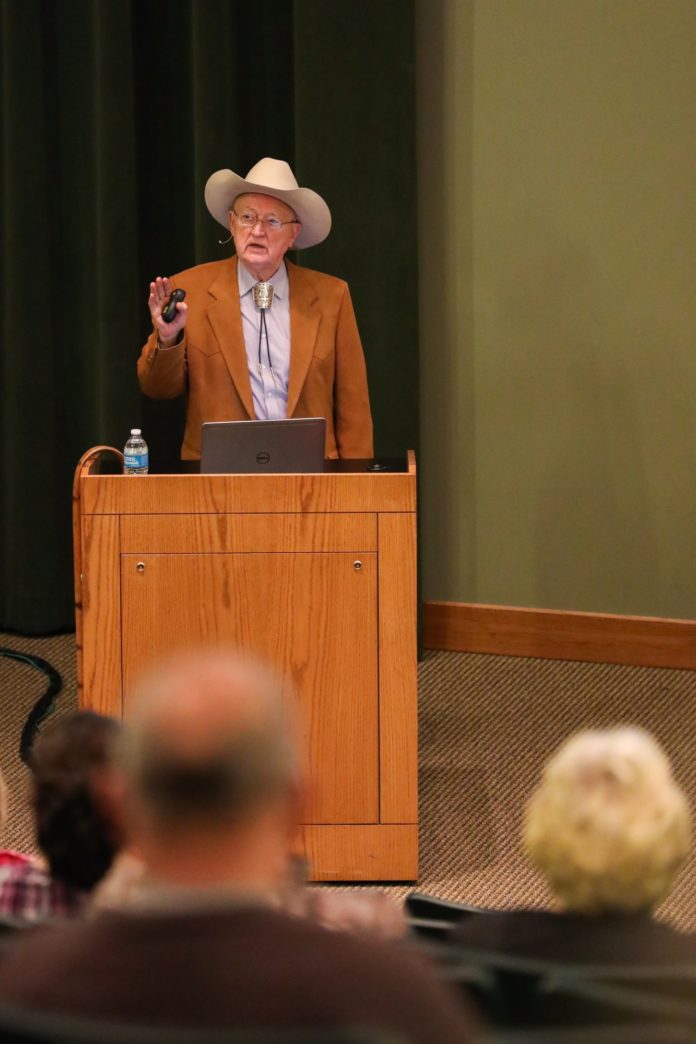
By Cassidy Pate | Reporter
A crowd of Wacoans and Baylor students saddled up and took a ride down the history of the Chisholm Trail on its 150th anniversary on Tuesday at the Mayborn Museum.
Doug Harman, renowned public speaker, spoke about the history, folklore and remaining legacy of the Chisholm Trail. His main goal was not to document the history, but to communicate the importance of its legacy and how the Waco community and beyond can benefit from it.
“There’s something for everybody when you talk about the Chisholm Trail, but then it comes back to us individually as communities and as the state of Texas,” Harman said. “How do we in fact utilize this piece of history?”
The Chisholm Trail went through Waco territory on its way to Kansas. Harman said his efforts to make the trail a National Historic Trail are going to be a big deal for the Waco community.
Cindee Millard, public programs manager of the Mayborn Museum, introduced Harman.
“He’s a man who wears many hats, and they’re not all cowboy hats,” Millard said.
Harman began by asking the audience how we, as Texans, can present or promote Texas and the Chisholm Trail’s history in an effective and authentic way. With this, Harman went into the history of how the Chisholm Trail was created and the cattle trails that came before it.
The Chisholm Trail spanned from the end of the Civil War in 1867 until 1885, and it remains the largest movement of cattle by man to date. Covering a 1,200-mile radius, the trail began in South Texas, running through Abilene into Kansas and ended in Oklahoma.
Harman said although the trail is known as the largest movement in the world, it also marks the biggest killing of buffalo.
Cowboys and cowgirls also faced many dangers along the Chisholm Trail including river crossings, stampedes, lack of daylight and Indians among other factors.
Because the travelers were paid during their 10-to 12 mile per day journeys, they needed somewhere to spend their money. Harman said each stop along the trail was built as an entertainment destination, which is how Fort Worth developed into a “cowtown”. Waco and San Antonio also served as trail destinations.
The people of the trail have become heroically known by popular culture in music, art, and film and T. Many of the early books about the people on the Chisholm Trail remain prevalent today. However, the image of the original cowboy and cowgirl have been portrayed differently than their realistic versions. Harman said Spanish vaqueros influenced the original cowboy, and the majority of the cowboys along the trail were young men.
Innovations also played a large role in the Chisholm Trail in ensuring the quality of the cattle, the speed at which the travelers and cattle moved with chuck wagons and railroads and the gear of the travelers.
Harman said that of the cattle that were transported only about 40 percent were sent to Chicago for meat processing while the remainder were directed north toward Montana for ranching.
An encyclopedia said the trail maintained this position until the areas south of Texas witnessed the building of additional railway trunk lines, which replaced the necessity of trails for the movement of cattle to the north.
To experience this trail and others similar to it, Harman brought up how exhibits, murals, and historical markers around Texas are working to enhance its history’s impact on its citizens.
“Chisholm Trail is a piece of our heritage, we need to keep it going,” Harman said.





